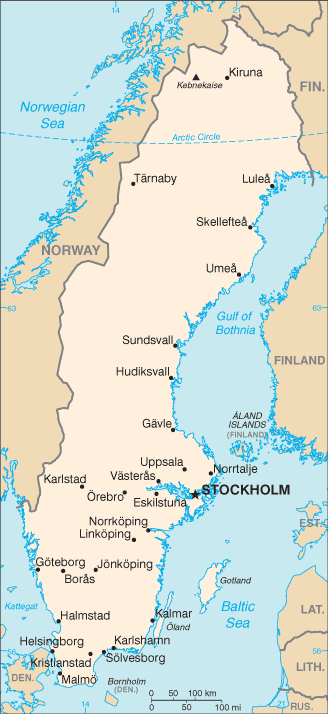Sweden
The Kingdom of Sweden (Swedish: Konungariket Sverige) is a Nordic country in Scandinavia, in Northern Europe. It is bordered by Norway on the west, Finland on the northeast, the Skagerrak Strait and the Kattegat Strait on the southwest, and the Baltic Sea and the Gulf of Bothnia on the east. Sweden has a low population density in all but its metropolitan areas, with most of the inland consisting of large peaceful forests and mountainous wilderness. The official list of Swedish monarchs starts about a 1000 years ago, about as long as Sweden has been Christian. After the allegedly notorious Vikings, Sweden spent a couple of centuries in battles with its neighbouring countries Denmark from the 12th century – 1710, and Norway in the 16th and 17th century. In the 17th and 18th centuries the Realm of Sweden was through warfare extended to a Great Power of twice its size – subsequently lost within a century. Since 1816, Sweden has been at peace, adopting a policy of armed neutrality. Sweden was first mentioned in the 1st century, by Roman historian Tacitus, who wrote that the Suiones lived out in the sea and were powerful in both arms and ships. After that, the sources are scarce. Sweden as a name originated in a so-called "back-formation" from the plural form Swedes (Old English Sweoðeod, Swedish Svear), the people of the Suiones. This referred to the inhabitants of Svealand primarily around lake Mälaren; towns of Stockholm, Sigtuna and Birka. The southern parts were on the other hand inhabited by Geats (Götar) in Götaland. With the Christianization in the 12th century, the country was consolidated, with its center at the water-ways of the northern Baltic and the Gulf of Finland. Like the rest of Europe it was in the 14th century struck by the Black Death (the Plague), with all the effect. But Sweden's expansion into the northern wilderness of Laplandia, the Scandinavian peninsula, and present-day Finland continued. In 1389, the three countries of Norway, Denmark and Sweden were united in the Kalmar Union under a single monarch. After several wars and disputes between the nations, the King Gustav I of Sweden (Vasa) ultimately broke free in 1521 and established a nation state, considered the Foundation of modern Sweden, and shortly thereafter carrying through a Protestant Reformation. Gustav Vasa is the closest to a Father of the Nation the Swedes know. The 17th century saw the rise of Sweden as one of the great powers in Europe, due to successful participation, initiated by King Gustav II Adolph, in the Thirty Years' War. Mighty as it was, it crumbled in the 18th century with Imperial Russia taking the reins of northern Europe in the Great Northern War, and finally in 1809 when the Grand Duchy of Finland was created out of the eastern half of Sweden. The Campaign against Norway, 1814, led to the Treaty of Kiel, whereby Norway was forced into a union with Sweden that wasn't dissolved until 1905. But the campaign also signified the last of the Swedish wars and its 200 years of peace are arguably unique in the world today. The 19th century saw a significant population increase, generally attributed to the three factors of peace, vaccination and potatoes, doubling the population from 1750 to 1850. Many people on the countryside, the home for the majority, found themselves out of work, leading to poverty and alcoholism. Therefore a massive emigration to mainly the U.S occurred 1850-1910. However, as the Industrial revolution in Sweden progressed during the century, people gradually began moving into the Swedish cities and factory work, where they organized in Socialistic unions. A threatening Socialist revolution was avoided in 1917, following the re-introduction of Parliamentarism, and the country was democratized. In the 20th century, Sweden remained neutral during World War I and World War II and continued to stay non-aligned during the Cold War – still today not being a member of any military alliance. Following the second World War, Sweden made use of its natural resources and undemolished state, making it possible to expand its industry to supply the rebuilding of Europe, leading to Sweden being one of the richest countries in the world by 1960. As other economies were re-established, Sweden was surpassed in the 1970's, but still ranks among the top nations concerning well being of its inhabitants.
This article is licensed under the GNU Free Documentation License. It uses material from the Wikipedia article "Sweden". |
|||||||||

